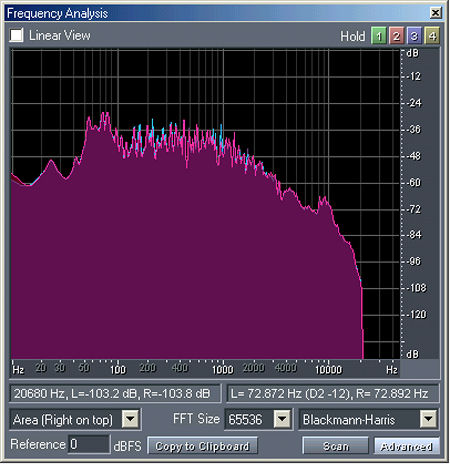| Columns Retired Columns & Blogs |
The 5th Element #26 "Cold Cold Heart" SACD vs CD
Sidebar: "Cold Cold Heart" SACD vs CD
When John Marks told me about his experience with Come Away With Me, I had just bought the SACD from Acoustic Sounds. I already had the CD, so I compared the two using a Musical Fidelity Tri-Vista SACD player. John was correct, if there was a difference between the CD and the two-channel SACD, it was beyond my ability to discern. I therefore examined the data on the two discs, using the Adobe Audition program running on a PC.
I ripped the audio data for "Cold Cold Heart" from the CD using Exact Audio Copy and upsampled it to a 24-bit file sampled at 96kHz. SACD players, of course, don't allow access to the raw DSD data on a disc, so I digitized the Musical Fidelity's analog output using a Metric Halo Mobile IO 2882 A/D converter connected to my PowerBook with a FireWire link. I ran the MIO 2882 at 96kHz sampling and 24-bit depth, and I used Bias Peak 4.0 to create an uncompressed two-channel AIFF file.
I had originally wanted to compare the files at the bit level, nulling one against the other to reveal the differences—if any! However, for this to work, the samples of both files have to be coincident in time. As SACD players do not output a downsampled PCM version of the DSD data, I couldn't slave the Metric Halo's A/D converter to the Musical Fidelity's digital output, which would have given me a AIFF file representing the SACD with its samples time-coincident with those of the CD. What I needed was an SACD transport with a word-clock input so that I could clock both the A/D converter and the transport from the CD data. The dCS Verdi SACD transport can be slaved to an external word clock, but there wasn't one availbale to me when I did this work.
I had under-recorded the transfer from the SACD version of "Cold Cold Heart" by 3dB or so, to make sure I didn't clip any peaks, so the first thing to do was to normalize this version to the peak level of the CD data. Fig.1 shows the overall waveform of the two-channel SACD version of the track; it peaks at -0.75dB with an average RMS level of -16.5dB (both figures the average of the two channels). These are both commendably low by modern standards, and as the waveform graph shows, there is a great deal of dynamic light and shade. (For a bad example, see the graphs showing a similar analysis of the CD layer on the 30th anniversary reissue of Pink Floyd's Dark Side of the Moon.)

Fig.1 "Cold Cold Heart," SACD version, waveform of entire track (20% modulation/vertical div., left channel top).
The waveform of the CD version of the same song was identical, as were the peak and RMS levels and the overall statistics of the data files. I turned to the frequency domain. Fig.2 shows an FFT-derived peak spectrum of the CD version of the song's data (the top of the graph is 0dBFS, the bottom -140dBFS). The spectrum is typical for acoustic instruments, with most of the energy concentrated in the midrange, with a smooth, consistent rolloff apparent in the treble (other than a slight amount of extra energy concentrated between 8 and 10kHz). The bass also rolls off below 55Hz. As is always the case with a PCM recording, there is no content above half the sample rate, ie, 22.05kHz in the case of the CD data shown here.

Fig.2 "Cold Cold Heart" CD version, spectral content of entire track (10Hz-48kHz frequency scale, 12dB/vertical div., left channel blue, right channel red).
For comparison, fig.3 shows the spectrum of the SACD-derived data. From 10Hz to 20kHz, this graph is identical to fig.2. Identical. The only difference is the presence of random noise above 22.05kHz, this increasing with frequency. This noise results from the aggressive noise-shaping that is fundamental to DSD encoding and is irrelevant to the recording's audioband content.

Fig.3 "Cold Cold Heart" SACD version, spectral content of entire track (10Hz-48kHz frequency scale, 12dB/vertical div., left channel blue, right channel red).
As far as I am concerned, John Marks is correct. (JM is also correct about Aja, of course, though I would replace Katy Lied with Gaucho.) The two-channel version of the music on the Come Away With Me SACD must indeed have been produced by running the resolution-limited and bandwidth-limited CD data through a DSD converter. I am equally sure that Blue Note will point to the fact that the multichannel mix on this SACD justifies its release, and I have no argument with that. But given that almost all audiophiles who buy this SACD will be listening to the two-channel tracks, that is cold comfort.—John Atkinson
- Log in or register to post comments




































